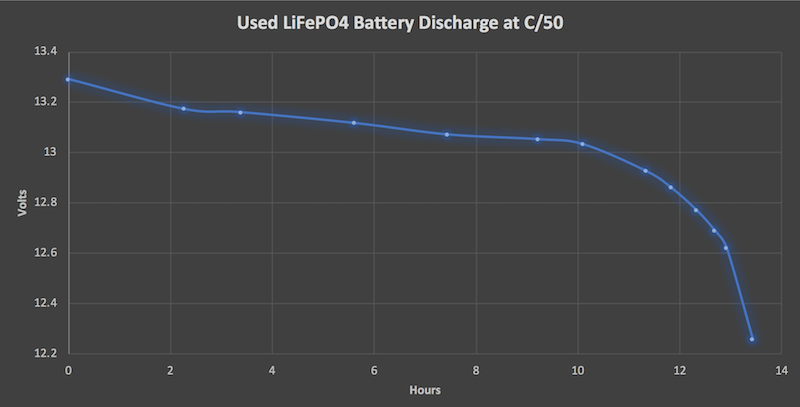
After more thorough testing of the used LiFePO4 battery that I described in my previous post, I’ve reached the sad conclusion that it’s essentially a worthless piece of junk. Encouraged by stories from mobile-solarpower.com and other sources, I’d hoped this used battery might still have about 80% the capacity of new. Even the battery’s own datasheet said an ‘end of life’ battery still retains 60% of the original capacity. But I measured the usable capacity at just 27-29% of original, and with a collection of other battery problems too. It’s basically unusable. What a disappointment. It’s an expensive lesson in the risks of buying used equipment.
The trouble began immediately after I unpacked the battery and measured 0 volts at the terminals. It was completely discharged, to the point where the low-voltage cutoff of the built-in Battery Management System had disconnected the cells. The seller said it was at 12.8V prior to shipping a week earlier, and it definitely shouldn’t have self-discharged so much over just one week.
I was able to recharge the battery with an Accucel 6 charger in LiFe mode, waking up the BMS and charging the battery to about 95-100%. But it reached a “full” charging voltage much too soon, at about 14.2V after putting in only 13 Ah. That’s roughly 29% of the battery’s nominal 45 Ah capacity. Not a good sign. Also worrying: the built-in BMS appeared to kick in at a charging voltage about 14.2-14.3V and disconnect the cells to prevent overcharging, which caused my charger to report an error. This contradicts the battery’s datasheet which says 14.6V is normal and the BMS won’t kick in until 15.6V.
After disconnecting the charger, I measured an open circuit voltage of 13.664V. Over the next day the voltage continuously dropped, though the rate of decay eventually slowed. At 20 hours post-charging, the voltage had dropped to 13.349V, or 3.337V per cell. According to this chart, this indicates a state of charge greater than 90%.

To perform a capacity test, I connected a 12V LED light with a measured current draw of 0.94 amps, and timed how long the battery survived. The setup is shown in the title photo above. During the test I also periodically measured the battery voltage. The battery lasted 13.5 hours, for a total measured capacity of 12.7 Ah or 29% of nominal capacity. That’s a very disappointing result, but at least it was consistent with the charging results. Here’s the discharge curve:

Not only did I get just 12.7 Ah instead of closer to 45 Ah, but there was another problem too. Five minutes after I measured the last data point (806 minutes, 12.259V) the battery completely shut off. This must have been the low-voltage cutoff of the BMS again, except it happened much too soon. The datasheet says a normal discharge continues down to 10.0V, and the BMS doesn’t engage until 8.8V! The discharge curve is very steep at this point, so I probably only missed out on about 5% of extra capacity, but it’s another indicator that things weren’t working correctly.
As a final test, the next day I recharged the battery a second time at just 1 amp charging current – C/45. That’s a very conservative rate, because I wanted to be sure I hadn’t somehow failed to actually charge the battery fully on the first time around. The results were even worse than before, and I only managed to put 12.1 Ah into the battery before it reached full, 27% of nominal capacity. After disconnecting the charger, I measured an open circuit voltage of 13.6V, which indicates a fully charged battery. So there’s no mistake… it’s just a dud.
So now I’m left with a $167.50 used battery with vastly less than the expected capacity, apparent BMS problems, and a possible self-discharge problem too. This seller didn’t make any specific performance claims other than that the battery came from “well-maintained equipment”, but I don’t think they intended to sell a battery in this poor state. If they were aware of the battery’s problems, I think an honest seller would have thrown it in the trash, or perhaps sold it with a warning like “for parts only – battery does not hold a full charge”.
I’ve contacted the seller to request a return or a refund. No reply yet. My strategy in such things is to explain nicely what I’m seeing, and ask politely for help, always working from the assumption that it’s a good faith misunderstanding. In my experience this works much better than angry rants and accusations.
Have you ever bought a used battery? How did it work out? What information might you look for when choosing a used battery to avoid problems like this? Leave a comment and share your thoughts.